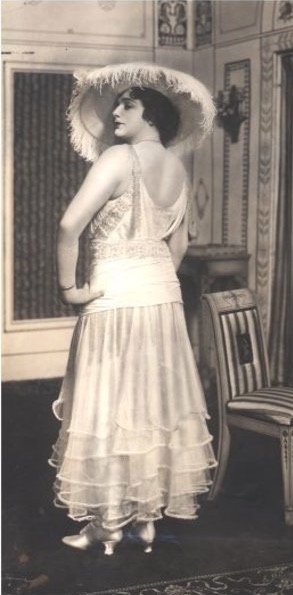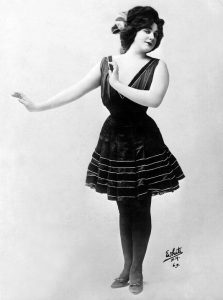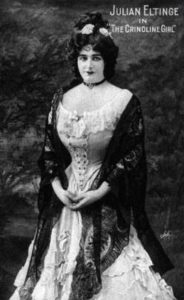Julian Eltinge, The Crinoline Girl
By Ms Bob & Carol Kleinmaier
Berkeley bookseller Burton Weiss called with a smile in his voice. The first thing out of his mouth was the collector’s favorite phrase, “I have something I think you’ll be interested in.” He was offering a folder of six photographically illustrated postcards from 1914 featuring Julian Eltinge in the Broadway production of The Crinoline Girl. It was easy to be interested in Julian Eltinge.
Critics, scholars and theater professionals agree Julian Eltinge was America’s most brilliant female impersonator. Even 15 years after his death in 1941 he was still acclaimed “the greatest of all female impersonators past, present — and even future!”(1) “Eltinge restored female impersonation to an art, from which it had fallen into the coarsest and most obvious slap-stick and buffoonery after the passing of the Restoration,”(2) the last era in which women were banned from the stage and men took their roles.
So how did Julian elevate female impersonation to an art and how was he able to maintain his popularity with the very moral American public? Ever since he was in his teens, he had specialized in female roles. Why always female roles? Julian would say that his choice of travesti was pragmatic. He got better parts, better billing and better money in drag. His work in minstrels shows, vaudeville, Broadway and film established the standard for success for the professional female impersonator in the 20th century.
Remember the mood of turn-of-the-century America, the macho America of Teddy Roosevelt and his Rough Riders — an era which would associate female impersonation with effeminacy. And since the 1895 trial of Oscar Wilde, effeminacy has been associated with “the love that dare not speak its name.” Eltinge, however, screened himself brilliantly, wrapping around his personal life a veil of carefully planned public relations stunts.
 Everyone knows queens can’t fight. So fresh out of college Eltinge “staged a rough-and-tumble fight in a Forty-Second Street and Ninth Avenue saloon, where he cleaned out the joint of tough characters because someone made a remark about female impersonators being ‘nances.'”(3) For the rest of his career Eltinge insisted vigorously on his manliness. However, in Great Pretenders Anthony Slide presents some mitigating, though circumstantial, evidence, ” At least one former vaudevillian whom I interviewed was quite positive that Eltinge was gay. Certainly he (Eltinge) never married, and he spent his declining years living with his mother at his California home.”(4)
Everyone knows queens can’t fight. So fresh out of college Eltinge “staged a rough-and-tumble fight in a Forty-Second Street and Ninth Avenue saloon, where he cleaned out the joint of tough characters because someone made a remark about female impersonators being ‘nances.'”(3) For the rest of his career Eltinge insisted vigorously on his manliness. However, in Great Pretenders Anthony Slide presents some mitigating, though circumstantial, evidence, ” At least one former vaudevillian whom I interviewed was quite positive that Eltinge was gay. Certainly he (Eltinge) never married, and he spent his declining years living with his mother at his California home.”(4)
Before Broadway Eltinge seasoned his decorous dames in vaudeville. He appeared as an elegant society lady in the height of fashion and sang popular songs. Vaudeville was family entertainment, very moral and proper. At the Palace Theater, vaudeville’s Valhalla, an actor couldn’t say cockroach on stage. Yet, even with these high moral standards Eltinge’s act was called “refined” and “never offensive.” His career was always “singularly free from scandal.”(5)
Eltinge also avoided the “cheap shot” in his performances, always presenting polished, professional performances. In 1908 every female thespian from divas to chorus girls performed Salome’s dance of the seven veils. Theater folks called it a “cooch” dance. We’d call it a “bump and grind.” And every Salome had to be unique. The competition was intense and these women stopped at nothing. Vaudevillian Eva Tanguay didn’t stop. She kept dancing and became the first star to removed all seven veils.
For travesti Salome’s dance was too easy to burlesque. Burly English female impersonator Malcolm Scott performed a riotous Salome with seven whisky bottles. “Lind”, another impersonator, never removed his wig, scandalously remaining a girl to the end. But Eltinge was never one to substitute gimmickry for craft; his Salome was described as simply “beautiful.”
The Fascinating Widow was Eltinge’s first Broadway vehicle. It made him a star, even though the Broadway run had been only 56 performances, opening at the Liberty Theater, September 11, 1911. The Widow then toured the US successfully for a few years. When Julian returned to New York in 1914 he was riding a wave of popularity. The New York Times hailed him as “one of the most popular and successful ‘road’ stars on the stage today.”
Al Woods, his producer, had made sure New Yorkers didn’t forget Eltinge while he was busy fascinating the provinces. On September 11,1912, Woods opened The Eltinge 42nd Street Theater, the eighth theater built on 42nd street. Though Eltinge may have never performed there, it was, not surprisingly, the only Broadway theater named for a female impersonator.
The Crinoline Girl was Eltinge’s second Broadway show. It opened at the Knickerbocker Theater on March 16, 1914. Both it and The Fascinating Widow were written by Otto Hauerbach. The plots share one element: a man is constrained by circumstance to dress as a woman. “Constrained by circumstance” describes 90% of all transvestite fiction, be it farce or fantasy. It’s everywhere from plays, Charlie’s Aunt (1892), to films, Some Like It Hot (1959); from Victorian pornography, The Petticoat Dominant (1898), to the latest dirty little fem-dom story on the net. The hero doesn’t want to do it. It’s not his choice, but there’s no other way. Tom Hale, Eltinge’s character in The Crinoline Girl , must drug the robber’s pretty accomplice and impersonate her, wearing her crinoline. How else can he catch the real thieves, save the jewels, earn $10,000 and marry the girl of his dreams?
Variety summed up The Crinoline Girl best: “Sure, it’s an old-fashioned farce with a melodramatic plot . . . and it won’t run a year in New York . . . Sure. . .the farcical situations are created by folks running in and out of doors. . .and much more of the same caliber. And what of it? Doesn’t it give the star, Julian Eltinge, a good excuse for appearing first as himself and then afford him an opportunity to pose as a woman without deceiving the audience and never once surrounding the female impersonator with an atmosphere that might prove offensive to the most particular individual? The main thing was to have Eltinge at all times a manly man, and this has been cleverly worked out.”
Julian Eltinge was probably the most popular female impersonator of this century, possibly in all of American history. And by this achievement he established a formula for success with mainstream audiences. First, present yourself as a professional entertainer who just happens to wear women’s costumes. As Danny La Rue, England’s preeminent impersonator, puts it, “I’m basically a comedian… just an actor playing a woman.”(8) Second, be sure to keep reminding the audience of your militant heterosexuality, as Australia’s Barry Humphries does balancing his female character, Dame Edna Everage, with the macho impersonation of Sir Les Patterson. Third, keep your life “singularly free from scandal.” And fourth, even though you may have the funniest risque “blue” material in show business, use it very selectively and be sure that it NEVER becomes the basis of your professional reputation. Wholesome is the watchword. This should be enough to assure the public that, though the actor wears a dress, he’s still a “real” man and a gentleman to boot.
Footnotes:
- Joe Lurie, Jr. Vaudeville: from the Honky-Tonks to the Palace (Henry Holt & Co., New York, NY, 1953), p. 91.
- C. J. Bulliet, Venus Castina (Covici Friede, New York, NY, 1933) p. 262.
- Lurie, p. 92.
- Anthony Slide, Great Pretenders (Wallace-Homestead Book Co., Lombard, IL, 1986), p. 29.
- Bulliet, p. 262.
- “Eltinge Succeeds in ‘Crinoline Girl'” (review) New York Times, March 17, 1914, Sec. 11, p. 3.
- Mark (sic), “The Crinoline Girl” (review) Variety, March 20, 1914, p. 20.
- Underwood, Peter, Life’s a Drag! Danny La Rue and The Drag Scene (Leslie Frewin Publishers Limited, London, UK, 1974), p. 9.
Earlier versions of this article have appeared in Lady Like Magazine #26, Spring, 1996, and Our Stories: The Newsletter of the Gay and Lesbian Historical Society of Northern California, Summer 1996, and on TGForum in 1997.
Category: History, Impersonation






